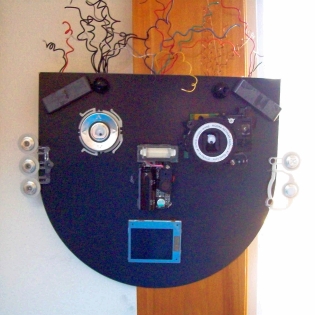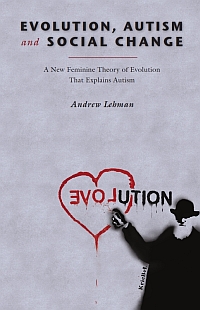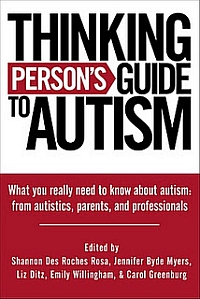If I Could Rewrite the DSM-IV Criteria for Autism (Part Two)
Diagnostic Criteria for 299.00 Autistic Disorder
How to Tell Whether Someone is Awe-tistic, Period
(I) A total of six (or more) items from (A), (B), and (C), with at least two from (A), and one each from (B) and (C):
(A) Qualitative impairment in social interaction, as manifested by at least two of the following:
(A) An unusual mode of social interaction, as manifested by at least two of the following:
(1) marked impairments in the use of multiple nonverbal behaviors such as eye-to-eye gaze, facial expression, body posture, and gestures to regulate social interaction
(1) A lack of reliance on the use of ambiguous nonverbal behaviors.
(2) failure to develop peer relationships appropriate to developmental level
(2) A love of solitude and solitary play.
(3) a lack of spontaneous seeking to share enjoyment, interest or achievements with other people, (e.g.. by a lack of showing, bringing, or pointing out objects of interest to other people)
(3) The understanding, gained uncannily early in life, that i) most people will not appreciate the awe-tist’s interests or achievements, and that ii) showing, bringing, or pointing out objects of interest will be met with judgment and/or hostility that can manifest in socially accepted forms of repression (such as social exclusion) or criminal acts (such as physical assault).
(4) lack of social or emotional reciprocity
(4) An acute sensitivity to the feelings of others that causes the awe-tist to refrain from using banal pleasantries or empty words that may hurt or offend.
(5) An altogether eccentric form of social and emotional reciprocity that insists upon fairness, directness, sensitivity, tolerance, substance, acceptance of difference, and mutually interesting subject matter.
(B) Qualitative impairments in communication as manifested by at least one of the following:
(B) Qualitative differences in thought and perception as manifested by at least one of the following:
1. delay in, or total lack of, the development of spoken language (not accompanied by an attempt to compensate through alternative modes of communication such as gesture or mime)
1. Visual and associative thought patterns that the awe-tist has difficulty translating into the more restrictive medium of verbal language.
2. in individuals with adequate speech, marked impairment in the ability to initiate or sustain a conversation with others.
2. An acute sensory and empathic sensitivity that makes spending extensive periods of time with people intensely difficult.
3. stereotyped and repetitive use of language or idiosyncratic language
3. An effort to use language despite the tremendous challenge of transitioning between visual/associative thinking and verbal/linear expression.
4. lack of varied, spontaneous make-believe play or social imitative play appropriate to developmental level
4. The development of all kinds of unique, idiosyncratic, and interesting ways to spend one’s time.
(C) restricted repetitive and stereotyped patterns of behavior, interests and activities, as manifested by at least two of the following:
(C) Specialized, disciplined, and brilliantly useful patterns of behavior, interests, and activities, as manifested by at least two of the following:
(1) encompassing preoccupation with one or more stereotyped and restricted patterns of interest that is abnormal either in intensity or focus
(1) A passion for one or more specialized subjects extraordinary in intensity and focus.
(2) apparently inflexible adherence to specific, nonfunctional routines or rituals
(2) An innate capacity for self-care that manifests itself in the creation of comforting routines and a fascination with patterns of all kinds.
(3) stereotyped and repetitive motor mannerisms (e.g. hand or finger flapping or twisting, or complex whole-body movements)
(3) An innate capacity for sensory self-regulation by means of various stims, which can encompass such soothing activities as joint compression, touching the comforting texture of soft fabrics, watching spinning objects, and other similarly enjoyable activities.
(4) persistent preoccupation with parts of objects
(4) An exceptional ability to work with objects in an unconventional fashion.
(II) Delays or abnormal functioning in at least one of the following areas, with onset prior to age 3 years:
(A) social interaction
(B) language as used in social communication
(C) symbolic or imaginative play.
(II) Because awe-tistic people often see the world in unusual ways, the difficulty of translating awe-tistic consciousness into the more restrictive medium of verbal language may result in the pathologizing of awe-tistic social interaction, language development, and play.
(III) The disturbance is not better accounted for by Rett’s Disorder or Childhood Disintegrative Disorder.
(III) The person’s awe-tistic consciousness is not better accounted for by some other type of hierarchical hair-splitting that results in life itself becoming a kind of disease.
Rachel Cohen-Rottenberg blogs at Journeys with Autism. If I Could Rewrite the DSM-IV Criteria for Autism appears here under the terms of this Creative Commons License.
Rachel Cohen-Rottenberg’s memoir is The Uncharted Path: My Journey with Late-Diagnosed Autism.
[image: Rachel Cohen-Rottenberg]
related: Time for This Elephant to Leave This Circus
Rachel Cohen-Rottenberg on 11/26/10 in featured, Society | No Comments | Read More


